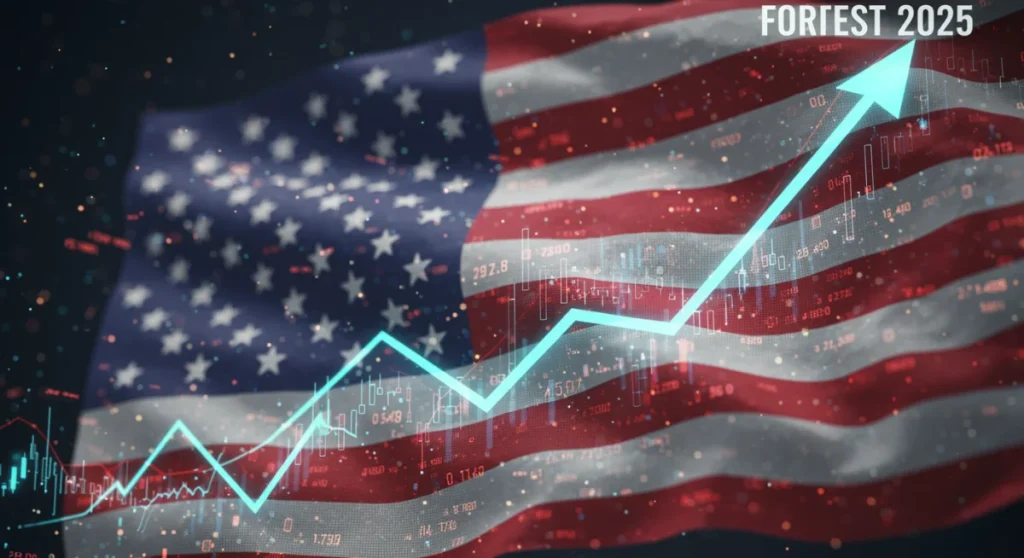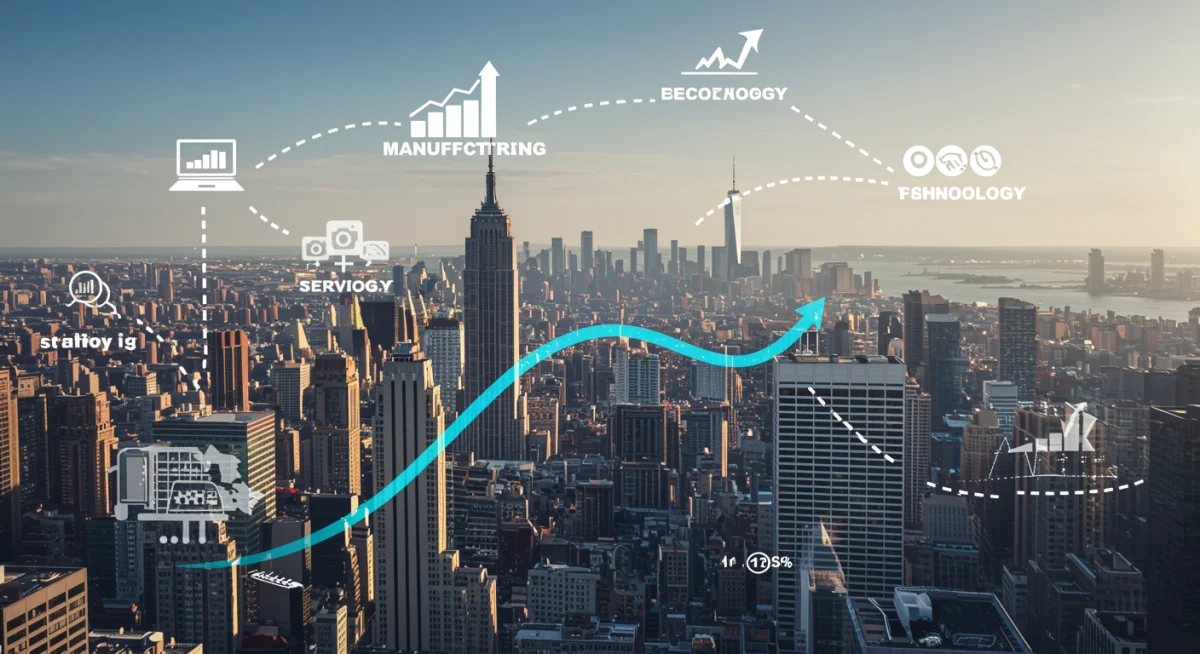Forecasting US Economic Growth for 2025: Key Indicators and Predictions

Anúncios
Forecasting US economic growth for 2025 necessitates a comprehensive analysis of monetary policy, consumer spending, labor market dynamics, and global geopolitical shifts to project future economic performance.
Anúncios
As we look towards the horizon, understanding the potential trajectory of US economic growth 2025 becomes paramount for businesses, investors, and policymakers alike. The coming year promises a complex interplay of domestic resilience, evolving global dynamics, and strategic policy decisions that will undoubtedly shape the nation’s financial future.
Anúncios
Understanding the Current Economic Landscape
Before peering into 2025, it’s crucial to grasp the foundational elements of the current US economy. Recent years have been marked by significant shifts, from the lingering effects of global health crises to unprecedented fiscal and monetary interventions. These factors have set the stage for the economic conditions we observe today, influencing everything from consumer behavior to corporate investment.
The US economy has demonstrated remarkable adaptability, navigating supply chain disruptions, inflationary pressures, and a dynamic labor market. While some sectors have shown robust growth, others continue to face headwinds. This mixed performance underscores the complexity of economic forecasting and the need for a nuanced approach.
Inflationary Pressures and Monetary Policy
Inflation has been a dominant theme in recent economic discussions. The Federal Reserve’s response, primarily through interest rate adjustments, has aimed to temper price increases without stifling economic activity. The effectiveness and timing of these measures will be critical in determining the economic environment of 2025.
- Interest Rate Trajectory: Future rate hikes or cuts will directly impact borrowing costs for consumers and businesses.
- Supply Chain Normalization: Continued improvement in global supply chains could ease inflationary pressures.
- Wage Growth: The balance between wage increases and productivity gains is vital for sustainable economic health.
In conclusion, the current economic landscape is a tapestry woven with threads of recovery, inflation, and policy responses. A thorough understanding of these elements provides the essential context for projecting future growth, emphasizing the interconnectedness of various economic forces.
Key Economic Indicators to Watch for 2025
Forecasting US economic growth 2025 relies heavily on monitoring a select set of key indicators. These metrics provide real-time insights into the health and direction of the economy, acting as barometers for future performance. Understanding their movements is fundamental for accurate predictions.
From consumer spending patterns to manufacturing output, each indicator offers a piece of the larger economic puzzle. Their collective behavior paints a picture of demand, production, and overall confidence within the marketplace.
Consumer Spending and Confidence
Consumer spending remains the largest component of US GDP. A confident consumer base, willing to spend on goods and services, fuels economic expansion. Indicators such as retail sales data, personal consumption expenditures (PCE), and consumer confidence surveys offer valuable insights.
- Retail Sales: Monthly reports track spending across various sectors.
- PCE Index: The Fed’s preferred measure of inflation, reflecting consumer price changes.
- Consumer Confidence Surveys: Provide sentiment data on current and future economic conditions.
Another crucial aspect is the labor market. A strong job market with low unemployment and steady wage growth supports consumer confidence and spending power. Conversely, a weakening labor market can quickly erode both, leading to reduced economic activity.
Monitoring these key economic indicators provides a robust framework for anticipating the direction of US economic growth in 2025. Their trends and interrelationships offer a clearer view of the challenges and opportunities ahead.
The Role of Monetary Policy and Interest Rates
Monetary policy, primarily orchestrated by the Federal Reserve, plays an indispensable role in shaping the economic outlook for 2025. The Fed’s decisions regarding interest rates and its balance sheet directly influence borrowing costs, investment decisions, and ultimately, the pace of economic activity.
The delicate balancing act involves controlling inflation while fostering sustainable growth. Too aggressive tightening can lead to a recession, while insufficient action can allow inflation to become entrenched. This makes the Fed’s forward guidance and actions a central focus for any economic forecast.
Federal Reserve’s Stance and Future Actions
The Fed’s communication regarding its inflation targets and employment mandates provides critical clues about its potential future moves. Analysts closely scrutinize statements from FOMC meetings and speeches by Fed officials for any indications of shifts in policy direction.
The path of interest rates, particularly the federal funds rate, will dictate the cost of capital for businesses and the interest rates on consumer loans, such as mortgages and auto loans. These rates have a ripple effect throughout the entire economy, influencing everything from housing market activity to corporate expansion plans.
Furthermore, the Fed’s quantitative tightening or easing policies, which involve adjusting the size of its balance sheet, also impact liquidity in the financial system. These actions can affect long-term interest rates and the availability of credit, adding another layer of complexity to economic projections.
In summary, the Federal Reserve’s monetary policy decisions, particularly on interest rates, will be a dominant factor in determining the trajectory of US economic growth 2025. Their actions will influence inflation, employment, and overall economic stability.
Global Economic Influences on US Growth
The US economy does not operate in isolation; it is deeply intertwined with global economic trends and geopolitical events. Therefore, any accurate forecast for US economic growth 2025 must consider the broader international context, including the health of major trading partners and potential global disruptions.
International trade, global supply chains, and cross-border investment flows all exert significant influence on domestic economic performance. Instability or growth in other major economies can have direct and indirect impacts on the United States.

Geopolitical Risks and Trade Relations
Geopolitical tensions, such as conflicts, trade disputes, and political instability in key regions, can introduce volatility and uncertainty into the global economic environment. These risks can disrupt supply chains, impact commodity prices, and dampen investor confidence worldwide.
- Energy Prices: Global events affecting oil and gas production can lead to significant price fluctuations.
- Trade Policies: Changes in international trade agreements or tariffs can impact US exports and imports.
- Currency Fluctuations: The strength of the US dollar relative to other major currencies affects trade competitiveness.
The economic performance of major global players, such as China and the European Union, also significantly affects US growth. A slowdown in these economies can reduce demand for US exports and impact multinational corporations with significant international operations. Conversely, robust growth abroad can provide a tailwind for the US economy.
Considering these global economic influences is essential for a holistic forecast. The interconnectedness of the modern world means that domestic economic health is increasingly sensitive to international developments, making external factors critical to understanding US economic growth in 2025.
Sector-Specific Outlooks and Innovation
While macro-economic indicators provide a broad view, a granular examination of specific sectors and the role of innovation offers deeper insights into the potential for US economic growth 2025. Certain industries are poised for significant expansion, driven by technological advancements, shifting consumer preferences, and strategic investments.
Innovation acts as a powerful engine for economic growth, creating new industries, enhancing productivity, and generating employment opportunities. Understanding which sectors are leading this charge is vital for a comprehensive economic outlook.
Technology and Digital Transformation
The technology sector continues to be a primary driver of economic growth, with ongoing advancements in artificial intelligence, cloud computing, and cybersecurity. These innovations are not only transforming the tech industry itself but also enabling digital transformation across virtually every other sector.
- Artificial Intelligence (AI): Increased adoption of AI across industries promises productivity gains and new product development.
- Renewable Energy: Investments in solar, wind, and other clean energy technologies are creating new jobs and infrastructure.
- Biotechnology and Healthcare: Advances in medical research and healthcare delivery continue to drive significant investment and innovation.
Beyond technology, other sectors like manufacturing, particularly advanced manufacturing, are experiencing a resurgence driven by automation and reshoring initiatives. The service sector, encompassing everything from finance to tourism, will also play a crucial role, reflecting consumer demand and business activity.
Analyzing these sector-specific trends and the underlying innovative forces provides a more detailed picture of where growth is likely to originate and how it will contribute to overall US economic growth in 2025. These areas often highlight the cutting edge of economic development and future prosperity.
Potential Risks and Opportunities for 2025
Forecasting US economic growth 2025 involves not only identifying probable trends but also assessing the range of potential risks and opportunities that could significantly alter the economic trajectory. A balanced perspective requires acknowledging both the headwinds and tailwinds that might emerge.
Economic predictions are inherently uncertain, and various unforeseen events or policy shifts can impact outcomes. Understanding these variables allows for better preparation and more resilient economic strategies.
Economic Headwinds and Tailwinds
Potential risks include persistent inflation, an unexpected downturn in the global economy, or domestic policy gridlock. These factors could dampen consumer and business confidence, leading to reduced investment and spending. High levels of national debt and potential fiscal challenges also present ongoing concerns.
- Recessionary Fears: The risk of an economic downturn, though hopefully mild, always looms.
- Inflation Resurgence: Unexpected price increases could force further restrictive monetary policy.
- Political Uncertainty: Domestic policy disagreements can create economic instability.
On the other hand, opportunities include sustained productivity growth driven by technological adoption, a resilient labor market continuing to support consumer spending, and potential breakthroughs in key industries. Effective policy responses to emerging challenges and a stable global environment could also provide significant tailwinds.
Moreover, the US economy’s inherent flexibility and capacity for innovation often allow it to adapt and overcome challenges, turning potential risks into opportunities for growth. This resilience is a key factor in its long-term economic performance.
In conclusion, a thorough forecast for US economic growth in 2025 must actively consider both the risks that could impede progress and the opportunities that could accelerate it. This balanced view is essential for navigating the complexities of the economic landscape.
| Key Economic Aspect | 2025 Outlook |
|---|---|
| Inflation | Expected to moderate closer to the Federal Reserve’s target, but watchful of supply shocks. |
| Interest Rates | Likely to stabilize or see modest cuts if inflation remains controlled. |
| Labor Market | Projected to remain robust with low unemployment, supporting consumer spending. |
| GDP Growth | Moderate but steady growth anticipated, driven by domestic demand and innovation. |
Frequently Asked Questions About 2025 US Economic Growth
Primary drivers for 2025 US economic growth are expected to be resilient consumer spending, continued technological innovation, and potentially a more stable global economic environment. Government spending and infrastructure investments also play a significant role in sustaining momentum.
Inflation is projected to moderate, moving closer to the Federal Reserve’s target. A controlled inflation rate would allow for more predictable consumer and business planning, potentially leading to stable interest rates and fostering sustainable economic expansion.
The Federal Reserve’s monetary policy decisions, particularly regarding interest rates, will be crucial. Their actions will aim to balance controlling inflation with supporting economic growth, influencing borrowing costs, investment, and the overall financial landscape.
Potential risks include geopolitical instability, unexpected resurgences of inflation, and a significant global economic slowdown. Domestic political uncertainty and unresolved fiscal challenges could also pose headwinds to sustained growth.
Sectors poised for significant growth include technology (especially AI and cloud computing), renewable energy, and biotechnology/healthcare. Advanced manufacturing and certain areas of the service sector are also expected to show robust performance, driven by innovation and demand.
Conclusion
Forecasting US economic growth 2025 reveals a landscape marked by both opportunities and challenges. While the underlying strength of consumer spending, a dynamic labor market, and continuous innovation provide a solid foundation, external global factors and careful monetary policy management will be crucial in steering the economy. The interconnectedness of domestic and international forces necessitates a vigilant approach to economic monitoring and strategic planning to ensure sustained prosperity.